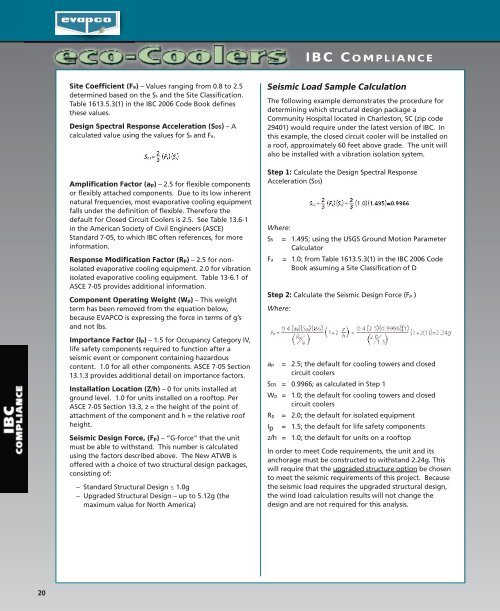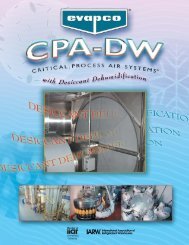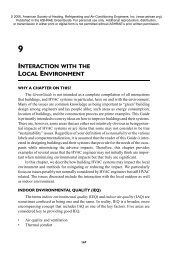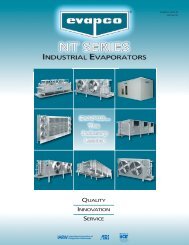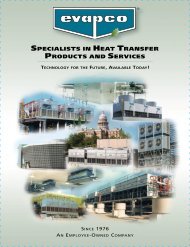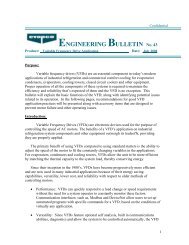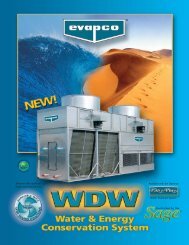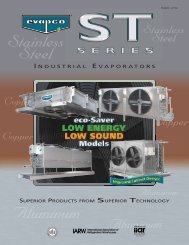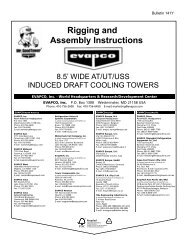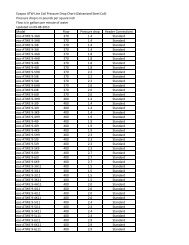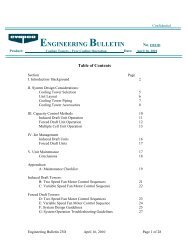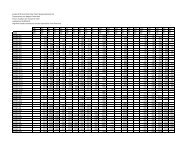eco-ATWB Marketing - Evapco
eco-ATWB Marketing - Evapco
eco-ATWB Marketing - Evapco
Create successful ePaper yourself
Turn your PDF publications into a flip-book with our unique Google optimized e-Paper software.
IBC COMPLIANCE<br />
Site Coefficient (Fa) – Values ranging from 0.8 to 2.5<br />
determined based on the Ss and the Site Classification.<br />
Table 1613.5.3(1) in the IBC 2006 Code Book defines<br />
these values.<br />
Design Spectral Response Acceleration (SDS) – A<br />
calculated value using the values for Ss and Fa.<br />
Amplification Factor (ap) – 2.5 for flexible components<br />
or flexibly attached components. Due to its low inherent<br />
natural frequencies, most evaporative cooling equipment<br />
falls under the definition of flexible. Therefore the<br />
default for Closed Circuit Coolers is 2.5. See Table 13.6-1<br />
in the American Society of Civil Engineers (ASCE)<br />
Standard 7-05, to which IBC often references, for more<br />
information.<br />
Response Modification Factor (Rp) – 2.5 for nonisolated<br />
evaporative cooling equipment. 2.0 for vibration<br />
isolated evaporative cooling equipment. Table 13-6.1 of<br />
ASCE 7-05 provides additional information.<br />
Component Operating Weight (Wp) – This weight<br />
term has been removed from the equation below,<br />
because EVAPCO is expressing the force in terms of g’s<br />
and not lbs.<br />
Importance Factor (Ip) – 1.5 for Occupancy Category IV,<br />
life safety components required to function after a<br />
seismic event or component containing hazardous<br />
content. 1.0 for all other components. ASCE 7-05 Section<br />
13.1.3 provides additional detail on importance factors.<br />
Installation Location (Z/h) – 0 for units installed at<br />
ground level. 1.0 for units installed on a rooftop. Per<br />
ASCE 7-05 Section 13.3, z = the height of the point of<br />
attachment of the component and h = the relative roof<br />
height.<br />
Seismic Design Force, (Fp) – “G-force” that the unit<br />
must be able to withstand. This number is calculated<br />
using the factors described above. The New <strong>ATWB</strong> is<br />
offered with a choice of two structural design packages,<br />
consisting of:<br />
– Standard Structural Design ≤ 1.0g<br />
– Upgraded Structural Design – up to 5.12g (the<br />
maximum value for North America)<br />
Seismic Load Sample Calculation<br />
The following example demonstrates the procedure for<br />
determining which structural design package a<br />
Community Hospital located in Charleston, SC (zip code<br />
29401) would require under the latest version of IBC. In<br />
this example, the closed circuit cooler will be installed on<br />
a roof, approximately 60 feet above grade. The unit will<br />
also be installed with a vibration isolation system.<br />
Step 1: Calculate the Design Spectral Response<br />
Acceleration (SDS)<br />
Where:<br />
SS = 1.495; using the USGS Ground Motion Parameter<br />
Calculator<br />
Fa = 1.0; from Table 1613.5.3(1) in the IBC 2006 Code<br />
Book assuming a Site Classification of D<br />
Step 2: Calculate the Seismic Design Force (Fp )<br />
Where:<br />
ap = 2.5; the default for cooling towers and closed<br />
circuit coolers<br />
SDS = 0.9966; as calculated in Step 1<br />
Wp = 1.0; the default for cooling towers and closed<br />
circuit coolers<br />
Rp = 2.0; the default for isolated equipment<br />
Ip = 1.5; the default for life safety components<br />
z/h = 1.0; the default for units on a rooftop<br />
In order to meet Code requirements, the unit and its<br />
anchorage must be constructed to withstand 2.24g. This<br />
will require that the upgraded structure option be chosen<br />
to meet the seismic requirements of this project. Because<br />
the seismic load requires the upgraded structural design,<br />
the wind load calculation results will not change the<br />
design and are not required for this analysis.<br />
20


